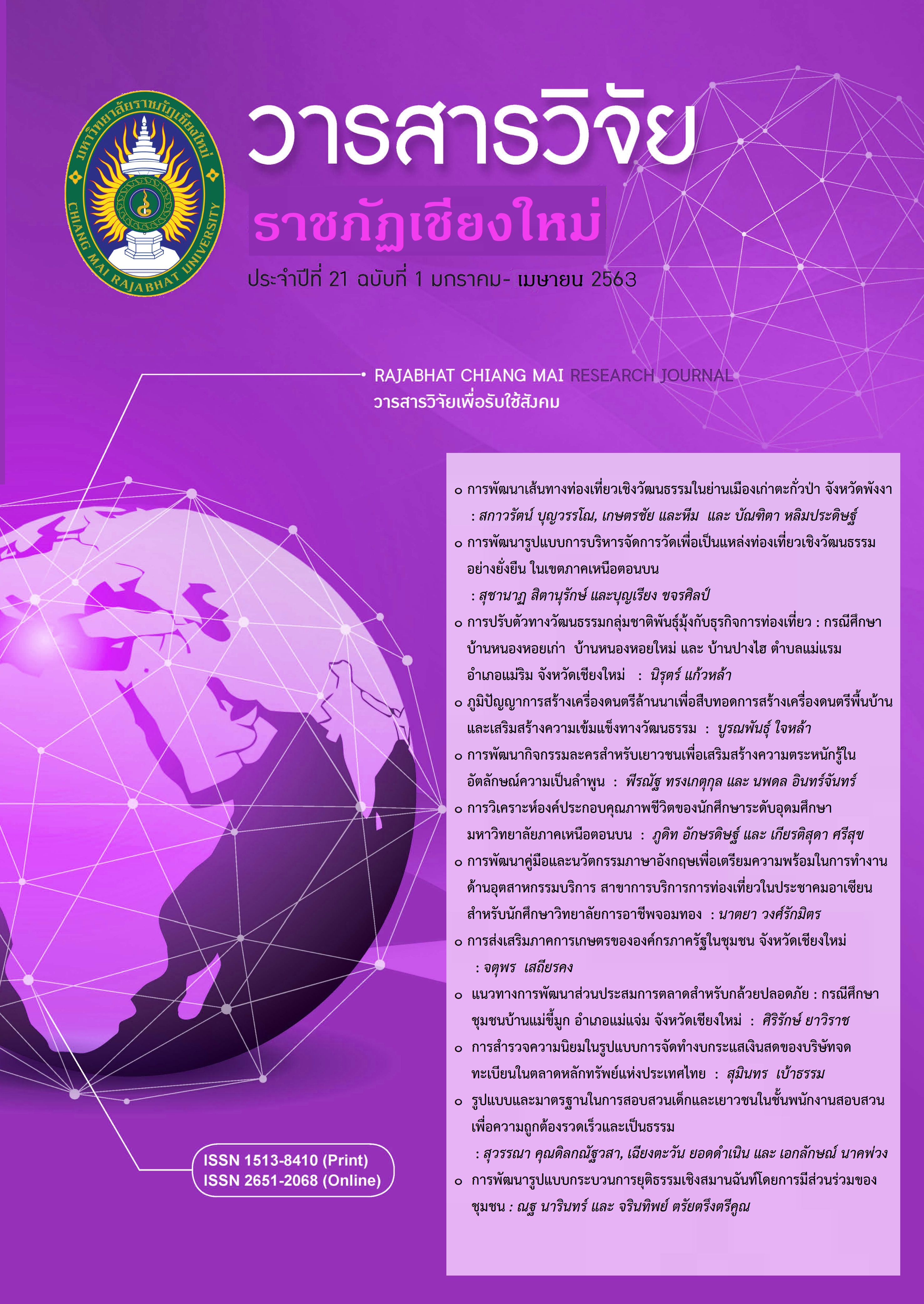Development Model of Restorative Justice by Participation of Community
DOI:
https://doi.org/10.14456/rcmrj.2020.219701Keywords:
Restorative justice, Participation of community, Community justiceAbstract
This research has objectives for study and develop model of restorative justice by participation of community. To study operation model of community justice Mae Tuen sub-district, Omkoi district, Chiang Mai province in management of problems that affect community of 4 villages are Ban Mai , Ban Huay Lor Dook, Ban Huay Dee Mor and Ban Mae Tuen Noi.
In order that, has qualitative research included studying current condition problems and model of restorative justice by field survey, conference with community to bring knowledge for evaluation in develop model of restorative justice.
The results revealed that community has drug problem, affray problem, land benefit problem and debt problem. Which community justice Mae Tuen sub-district initially cannot use model of restorative justice by participation of community for problems management because of commissioner lack of understanding in the role to operation, lack of systematic management, lack of public relations to community. Researchers have to bring the problems for solving process by community. Found that each village has model for solving problems by conciliation under sub-district headman, village headman, community leader to be the main part with community, village rules, methods to reimburse the offense, restoring relations for solving problems by themselves. That community justice Mae Tuen sub-district can take the results to develop operation model. However, should be support from central authority for develop skills, knowledge and evaluate the guideline to give community justice Mae Tuen sub-district can provide justice for community.
Downloads
References
กลุ่มพัฒนาและส่งเสริม ระบบงานยุติธรรม สำนักงานยุติธรรมจังหวัดเชียงใหม่. (2560). คำสั่งที่ ยธ 02039/16090 เรื่องการแต่งตั้งคณะกรรมการศูนย์ยุติธรรมชุมชนและการขับเคลื่อนศูนย์ยุติธรรมชุมชน . เอกสารอัดสำเนา. สำนักงานยุติธรรมจังหวัดเชียงใหม่. เชียงใหม่.
กิตติพงษ์ กิตยารักษ์. (2550). ยุติธรรมชุมชน: บทบาทการอำนวยความยุติธรรมโดยชุมชนเพื่อชุมชน. พิมพ์ครั้งที่ 5. กรุงเทพมหานคร: โครงการพัฒนาระบบกฎหมายไทยสำนักงานกองทุนสนับสนุนการวิจัย.
โกวิทย์ พวงงาม. (2553). การจัดการตนเองของชุมชนและท้องถิ่น. กรุงเทพมหานคร: บพิธการพิมพ์.
ณัฐวสา ฉัตรไพฑูรย์. (2550). กระบวนการยุติธรรมเชิงสมานฉันท์: จากทฤษฎีสู่ทางปฏิบัติในนานาชาติ. จัดพิมพ์ เนื่องในวาระครบรอบ 300 ปี ของคณะนิติศาสตร์ มหาวิทยาลัยเอดินบะระ. สกอตแลนด์: คณะนิติศาสตร์ มหาวิทยาลัยเอดินบะระ.
เพลินตา ตันรังสรรค์. (2553). กระบวนการยุติธรรมเชิงสมานฉันท์กับการกระทำความผิดอาญาของเด็กหรือเยาวชน. จุลนิติ, 7(6), 54-62.
ภูวน อุ่นจันทร์, สุมิตร สุวรรณ และสันติ ศรีสวนแตง. (2561). กระบวนการอำนวยความยุติธรรมชุมชน: ข้อเสนอจากประเด็นวิพากษ์และกรณีศึกษาเชิงประจักษ์. วารสารสังคมสงเคราะห์ศาสตร์, 26(1), 227-260.
สัญญพงศ์ ลิ่มประเสริฐ, สุจินต์ เสนาแพทย์, รพีพร สายสงวน และวศิน อุสันโน. (2562). ยุติธรรมชุมชน: กระบวนการยุติธรรมทางเลือกในสังคมไทย. งานประชุมวิชาการระดับชาติ มหาวิทยาลัยรังสิต ประจำปี 2562. สืบค้นจาก https://rsucon.rsu.ac.th/proceedings
เสน่ห์ จามริก. (2540). การเมืองไทยกับพัฒนาการรัฐธรรมนูญ. (พิมพ์ครั้งที่ 2). กรุงเทพมหานคร: มูลนิธิโครงการตำราสังคมศาสตร์และมนุษยศาสตร์.
สำนักงานยุติธรรมจังหวัดเชียงใหม่, (2557). การประชุมเชิงกำหนดแนวทางปฏิบัติในการจัดตั้งศูนย์ยุติธรรมชุมชนนำร่อง จังหวัดเชียงใหม่, เอกสารประกอบการประชุม วันที่ 22 เมษายน 2557. สำนักงานยุติธรรมจังหวัดเชียงใหม่. เชียงใหม่.
Braitwaite, J. (1989). Crime Shame and Reintegration. New York: Cambridge University Press.
Christie, N. (1977). Conflicts as Property, British Journal of Criminology, 17(1), 1-14.
Cohen, J. and Uphoff, N. (1980). Participation’s Place in Rural Development: Seeking Clarify Through Specify. World Development, 8(3), 213-235.
Galaway, B. and Hudson, J. (eds.). (1966). Restorative Justice: International Perspective. New York: Criminal Justice Press.
Karp, D. and Clear, T. (2000). Community Justice: Conceptual Framework, in Boundary Change in Criminal Justice Organization. USA: Washington D.C. National Institute of Justice.
Marshall,T. (1999). Restorative Justice an Overview. London: HMSO.
Power, P. (1996). An Evaluation of Community Youth Conferencing in New South Wales, A report to the New South Wales Attorney General. Attorney General Department of New South Wales. New South Wales.
The report of the Truth and Reconciliation Commission. (2017). Truth and Reconciliation Commission of South Africa Report. Retrieved from https://www.justice.gov.za./trc/report/finalreport/volume1.pdf
Umbreit, M. and Greenwood J. (1998). National survey of victim offender mediation programs in the United States Minnesota: Centre for Restorative Justice and Peacemaking. Retrieved from https://www.ncjrs.gov/ovc_archives/reports/restorative_justice/restorative_justice_ascii_pdf/ncj176350.pdf
Umbreit, M. (1998). Restorative justice through Victim–offender mediation: Western Criminology Review. Retrieved from https://wcr.sonoma.edu/v1n1/umbreit.html
Yukon Territorial Court and Justice Canada. (1996). R v Richard James Gingell, 50 CR (4th) 326.
Young, R. and Goold, B. (1999). Restorative Police Caution in Aylesbury-from Degrading to Reintegrative Shaming Ceremony. Criminal Law Review, 126.
Zehr, H. (1990). Changing Lenses: A New Focus for Crime and Justice Scottsdale. Pennsylvania. Waterloo Ontario: Herald Press.
Zehr, H. and Braithwaite, J. (1995). Re-Thinking Criminal Justice: Restorative Justice. USA: National Criminal Justice Reference Service.
Downloads
Published
How to Cite
Issue
Section
License
1. Articles, information, content, images, etc published in the “Community and Social Development Journal” are copyrighted by the Community and Social Development Journal, Chiang Mai Rajabhat University. In order to properly distribute the articles through print and electronic media, the authors still hold the copyright for the published articles under the Creative Commons Attribution (CC BY) license, which allows the re-distribution of the articles in other sources. References must be made to the articles in the journal. The authors are responsible for requesting permission to reproduce copyrighted content from other sources.
2. The content of the articles appearing in the journal is the direct responsibility of the article authors. The editorial board of the journal does not necessarily agree with or share any responsibility.














